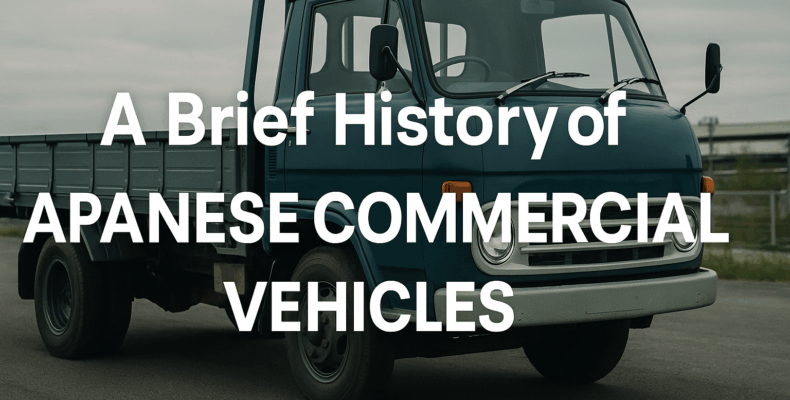Today, Japanese commercial vehicles are trusted worldwide for their reliability, fuel efficiency, and long service life. From Isuzu ELF trucks in Africa to Hino Dutro units in Southeast Asia, their global presence is undeniable.
But how did this dominance begin? And what makes Japanese trucks such a popular choice for exporters and buyers alike?
Let’s take a look at the history of Japanese commercial vehicles and discover why they continue to lead the global used truck market.
🚛 Post-War Beginnings: 1940s–1950s
After World War II, Japan’s infrastructure was devastated. However, the demand for affordable transportation grew quickly. As a result, domestic truck makers began developing small, durable vehicles to serve local businesses and farmers.
Key milestones:
-
1949: Isuzu launches its first post-war truck, the TX80, helping restart Japan’s economy.
-
1950s: Toyota and Nissan begin producing light-duty trucks.
-
1955: Mitsubishi enters the commercial vehicle market with Fuso trucks.
Even during this early stage, Japanese manufacturers prioritized simplicity and durability—traits that remain today.
🔧 Rapid Growth and Technological Shifts: 1960s–1980s
As Japan’s economy boomed in the 1960s, so did truck production. Brands focused on innovation, fuel savings, and performance.
-
1963: Isuzu introduces the first direct-injection diesel engine in a Japanese truck.
-
1970s: Emissions regulations lead to cleaner, more efficient engines.
-
1980s: Automatic transmissions and power steering become available, improving driver comfort.
Additionally, trucks like the Hino Ranger and Nissan Atlas began gaining traction in overseas markets. During this time, Japan became known for exporting not just cars—but commercial vehicles as well.
🌐 Export Expansion and Global Reputation: 1990s–2000s
During the 1990s, used truck exports expanded rapidly. Many developing countries turned to Japanese used trucks due to their low price and long-lasting quality.
-
Isuzu ELF and Toyota Dyna became top sellers in the Philippines, Kenya, and the Middle East.
-
4WD models proved reliable on rough terrain, from rural Africa to the highlands of Nepal.
-
Japan’s strict vehicle inspection system (Shaken) led to early trade-in of trucks in good condition, fueling the used market.
As a result, buyers started associating Japanese trucks with value, reliability, and easy maintenance.
📦 Modern Era: 2010s–Today
Today’s Japanese trucks continue to evolve. Manufacturers are focused on environmental technology, connectivity, and global compliance.
-
Hybrid and electric trucks are being tested by Isuzu and Hino.
-
Telematics systems like Truckonnect allow real-time GPS and performance tracking.
-
Exporters now include inspection sheets, JEVIC certificates, and live video for global customers.
Despite modern features, the core values remain: efficiency, durability, and driver safety.
🛠️ Why Japanese Used Trucks Are Still in Demand
Even after decades, Japanese trucks continue to dominate the global market. Here’s why:
-
Strict domestic maintenance laws ensure trucks are well-kept.
-
Right-hand drive models fit many markets in Africa, Asia, and Oceania.
-
Brands like Hino, Isuzu, and Mitsubishi Fuso have long service networks abroad.
-
Fuel efficiency and parts availability reduce long-term costs.
Global buyers also appreciate the consistent documentation, especially auction sheets and grade reports.
👉 Looking for trusted exporters? Start here:
Top 5 Trusted Japanese Used Truck Exporters for Global Buyers
These exporters understand regional needs and offer transparent deals.
✅ Final Thoughts
The journey of Japanese commercial vehicles began in post-war Japan, but today, their story continues across continents. From rugged farm deliveries in Kenya to urban logistics in Indonesia, these trucks carry more than cargo—they carry a reputation.
If you’re thinking of importing a used truck, remember: you’re not just buying a vehicle—you’re buying a legacy.
Would you like a 16:9 blog banner image with the title:
“A Brief History of Japanese Commercial Vehicles”
featuring vintage and modern Japanese trucks side-by-side? I can generate that for you now.
